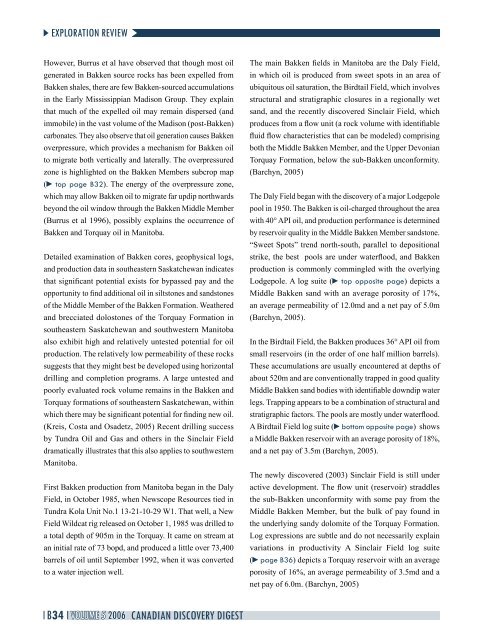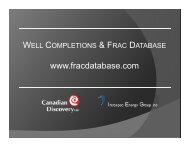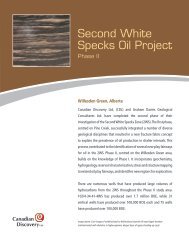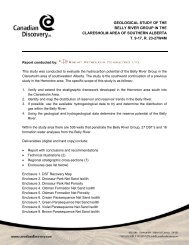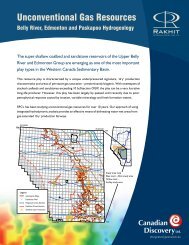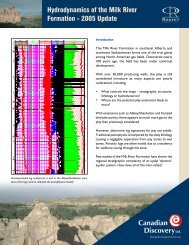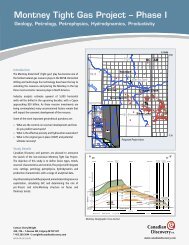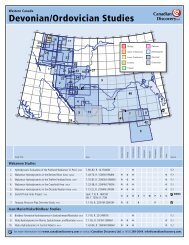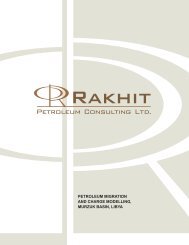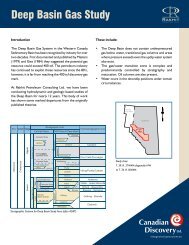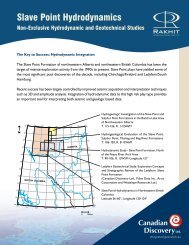exploration review THE BAKKEN AT ANTLER AND SINCLAIR
exploration review THE BAKKEN AT ANTLER AND SINCLAIR
exploration review THE BAKKEN AT ANTLER AND SINCLAIR
Create successful ePaper yourself
Turn your PDF publications into a flip-book with our unique Google optimized e-Paper software.
EXPLOR<strong>AT</strong>ION REVIEW<br />
However, Burrus et al have observed that though most oil<br />
generated in Bakken source rocks has been expelled from<br />
Bakken shales, there are few Bakken-sourced accumulations<br />
in the Early Mississippian Madison Group. They explain<br />
that much of the expelled oil may remain dispersed (and<br />
immobile) in the vast volume of the Madison (post-Bakken)<br />
carbonates. They also observe that oil generation causes Bakken<br />
overpressure, which provides a mechanism for Bakken oil<br />
to migrate both vertically and laterally. The overpressured<br />
zone is highlighted on the Bakken Members subcrop map<br />
( top page B32). The energy of the overpressure zone,<br />
which may allow Bakken oil to migrate far updip northwards<br />
beyond the oil window through the Bakken Middle Member<br />
(Burrus et al 1996), possibly explains the occurrence of<br />
Bakken and Torquay oil in Manitoba.<br />
Detailed examination of Bakken cores, geophysical logs,<br />
and production data in southeastern Saskatchewan indicates<br />
that significant potential exists for bypassed pay and the<br />
opportunity to find additional oil in siltstones and sandstones<br />
of the Middle Member of the Bakken Formation. Weathered<br />
and brecciated dolostones of the Torquay Formation in<br />
southeastern Saskatchewan and southwestern Manitoba<br />
also exhibit high and relatively untested potential for oil<br />
production. The relatively low permeability of these rocks<br />
suggests that they might best be developed using horizontal<br />
drilling and completion programs. A large untested and<br />
poorly evaluated rock volume remains in the Bakken and<br />
Torquay formations of southeastern Saskatchewan, within<br />
which there may be significant potential for finding new oil.<br />
(Kreis, Costa and Osadetz, 2005) Recent drilling success<br />
by Tundra Oil and Gas and others in the Sinclair Field<br />
dramatically illustrates that this also applies to southwestern<br />
Manitoba.<br />
First Bakken production from Manitoba began in the Daly<br />
Field, in October 1985, when Newscope Resources tied in<br />
Tundra Kola Unit No.1 13-21-10-29 W1. That well, a New<br />
Field Wildcat rig released on October 1, 1985 was drilled to<br />
a total depth of 905m in the Torquay. It came on stream at<br />
an initial rate of 73 bopd, and produced a little over 73,400<br />
barrels of oil until September 1992, when it was converted<br />
to a water injection well.<br />
The main Bakken fields in Manitoba are the Daly Field,<br />
in which oil is produced from sweet spots in an area of<br />
ubiquitous oil saturation, the Birdtail Field, which involves<br />
structural and stratigraphic closures in a regionally wet<br />
sand, and the recently discovered Sinclair Field, which<br />
produces from a flow unit (a rock volume with identifiable<br />
fluid flow characteristics that can be modeled) comprising<br />
both the Middle Bakken Member, and the Upper Devonian<br />
Torquay Formation, below the sub-Bakken unconformity.<br />
(Barchyn, 2005)<br />
The Daly Field began with the discovery of a major Lodgepole<br />
pool in 1950. The Bakken is oil-charged throughout the area<br />
with 40° API oil, and production performance is determined<br />
by reservoir quality in the Middle Bakken Member sandstone.<br />
“Sweet Spots” trend north-south, parallel to depositional<br />
strike, the best pools are under waterflood, and Bakken<br />
production is commonly commingled with the overlying<br />
Lodgepole. A log suite ( top opposite page) depicts a<br />
Middle Bakken sand with an average porosity of 17%,<br />
an average permeability of 12.0md and a net pay of 5.0m<br />
(Barchyn, 2005).<br />
In the Birdtail Field, the Bakken produces 36° API oil from<br />
small reservoirs (in the order of one half million barrels).<br />
These accumulations are usually encountered at depths of<br />
about 520m and are conventionally trapped in good quality<br />
Middle Bakken sand bodies with identifiable downdip water<br />
legs. Trapping appears to be a combination of structural and<br />
stratigraphic factors. The pools are mostly under waterflood.<br />
A Birdtail Field log suite ( bottom opposite page) shows<br />
a Middle Bakken reservoir with an average porosity of 18%,<br />
and a net pay of 3.5m (Barchyn, 2005).<br />
The newly discovered (2003) Sinclair Field is still under<br />
active development. The flow unit (reservoir) straddles<br />
the sub-Bakken unconformity with some pay from the<br />
Middle Bakken Member, but the bulk of pay found in<br />
the underlying sandy dolomite of the Torquay Formation.<br />
Log expressions are subtle and do not necessarily explain<br />
variations in productivity A Sinclair Field log suite<br />
( page B36) depicts a Torquay reservoir with an average<br />
porosity of 16%, an average permeability of 3.5md and a<br />
net pay of 6.0m. (Barchyn, 2005)<br />
B34 VOLUME 5 2006 CANADIAN DISCOVERY DIGEST


